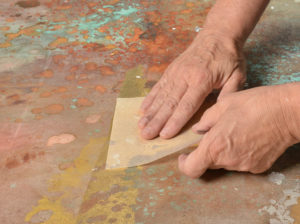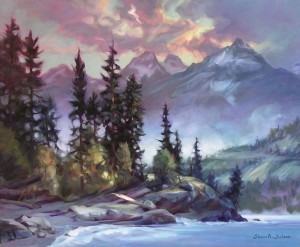Dear Artist,
When I was a boy my dad owned a sign shop. There were four employees: Nort, Mort, Phil and Bert. Each had their specialty — show cards, banners, silkscreen, illustration. It seems my dad was always walking around and asking, “Do you have something to get on with?” Dad lived in fear that one or the other would run out of something to do.
The situation is similar to the plight of the self-employed artist. Of course, there’s generally no Nort, Mort, Phil or Bert. But like it was with those boys, getting started might be a problem, as well as getting stopped, but as long as one is in the middle, things are okay, just like my dad and his creative company.
Yesterday I tackled a 60 x 60 inch. I had been looking at that blank canvas for about a week — watching a motif struggling to emerge like a photo in a tray of slow developer. Finally the canvas propelled itself to the easel and I got going. Working largely out of my mind I committed thick and fast. It seemed a long road ahead — perhaps this might become a tiresome project — like one of those big real estate development signs with lots of lettering, a site plan and an architectural rendering. But as soon as the start was made, there was stuff to get on with. It’s what I was talking about in the last letter — letting the project and its process engage, make demands, take over. With every stroke a need arose for another stroke — to correct, tone down, brighten up, redesign, simplify, complexify. Many artists relate to this exciting engagement that can lead to forgetting to check the mail, or eating, or bathing. There’s always something to get on with, actually one damn thing after the other. Eventually there comes a time when there’s nothing more to do. We made a photographic record of the progress of this particular painting — its faults, fumbles, and hopefully, its recoveries, in the form of a slideshow, here.
While results may not always be totally brilliant, having something to get on with is still one of the great feelings. This particular job and this condition lasted two days. Now I’ve written this and I’m going to have a tub.
Best regards,
Robert
PS: “Boldness has genius, power and magic. Engage, and the mind grows heated. Begin, and the work will be completed.” (Goethe)
Esoterica: Frequently artists say, “I don’t really know what I’m doing.” This is generally followed by the idea that somehow they muddle through and somehow they work it out. That’s creativity. But creativity is also being efficient. To me it’s important to proceed in a somewhat logical order. Order requires thinking ahead, planning, anticipating. Management is an acquired skill. You’re the boss.
 This letter was originally published as “Something to get on with” on February 13, 2004.
This letter was originally published as “Something to get on with” on February 13, 2004.
You can see the complete Ramparts slideshow, here.
The Letters: Vol. 1 and 2, narrated by Dave Genn, are available for download on Amazon, here. Proceeds of sales contribute to the production of The Painter’s Keys.
“The only bad studio is an unused one. “ (Robert Genn)
Featured Workshop
Traditional Japanese mineral pigment painting with Judith Kruger. Make water-based paint from cured shells, minerals, soils, pine soot, indigo and cochineal with natural glue. Learn to stretch Kumohadamashi paper and prepare wood panels. Metallic leafing and oxidation techniques will be covered. Emphasis on the creation of purposeful, multi-layered paintings stemming from ancient practices that embody the power to nurture the spirit. Historical information and powerpoint presentation included. Traditional and abstract painters are welcome. All levels.
More info on http://www.judithkruger.com
Featured Artist
Shawn’s paintings evoke the feelings of the West Coast, its shores and islands, ponds and lakes.








7 Comments
Love seeing the inside of Robert’s studio.
Thank you for the wisdom and “push” as I too have something to get on with, but haven’t!
I love the concept of this article, and the quote by Goethe. Beginning it truly the hard part!
Just looked at the slide show, and am now studying the enlarged photo of the studio. So Robert is wearing a hat inside. There are some small paintings set up together near the window, probably for analysis, other paintings probably in various stages of finish here and there on the floor. A pile of what looks like blank canvases on the right. Some empty frames. Nice windows with view to garden and beyond.
I’m curious if he had a certain number of finished works he liked to have in inventory at any given time, and how many blank canvases ready to go. Did Robert prefer certain sizes? Did he buy ready-made canvas or stretch his own?
This all goes to my current issue of building inventory ready to approach galleries and have on hand for people who want to stop by the studio to possibly buy something. It goes to having enough materials so that you can act immediately on a painting idea and also follow through all the way to hanging. Robert wrote once about how happy he was to be able to earn a living from his art, but getting it really up and running later in life is quite a challenge and an investment in time and resources.
Thanks Sarah, fascinating, and so moving to see your Dad at work.
Thank you
Sara, thank you for presenting this one again. It both thrills my artist’s heart and deeply saddens me to see this posting about your father’s excellent painting. I am so grateful that we can still benefit from his love of art and life and so sad that he is no longer breathing the air of our earth. But because of you and the wonders of modern technology, we can still delight in what he left behind and what you are so thankfully sharing with all of us. I love having the slide show and all his personal comments. He is one of the rare artists who could talk about his work as well as he could paint. I wish I could thank you in person and give you a great big hug. But here is an electronic THANK YOU!